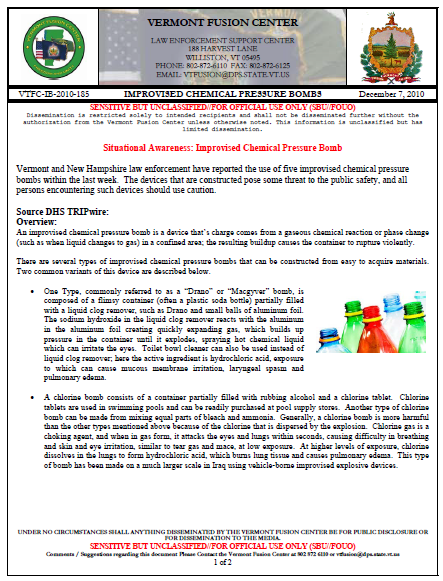Situational Awareness: Improvised Chemical Pressure Bomb
- 2 pages
- Sensitive But Unclassified
- For Official Use Only
- December 7, 2010
An improvised chemical pressure bomb is a device that’s charge comes from a gaseous chemical reaction or phase change (such as when liquid changes to gas) in a confined area; the resulting buildup causes the container to rupture violently. There are several types of improvised chemical pressure bombs that can be constructed from easy to acquire materials. Two common variants of this device are described below.
- One Type, commonly referred to as a “Drano” or “Macgyver” bomb, is composed of a flimsy container (often a plastic soda bottle) partially filled with a liquid clog remover, such as Drano and small balls of aluminum foil. The sodium hydroxide in the liquid clog remover reacts with the aluminum in the aluminum foil creating quickly expanding gas, which builds up pressure in the container until it explodes, spraying hot chemical liquid which can irritate the eyes. Toilet bowl cleaner can also be used instead of liquid clog remover; here the active ingredient is hydrochloric acid, exposure to which can cause mucous membrane irritation, laryngeal spasm and pulmonary edema.
- A chlorine bomb consists of a container partially filled with rubbing alcohol and a chlorine tablet. Chlorine tablets are used in swimming pools and can be readily purchased at pool supply stores. Another type of chlorine bomb can be made from mixing equal parts of bleach and ammonia. Generally, a chlorine bomb is more harmful than the other types mentioned above because of the chlorine that is dispersed by the explosion. Chlorine gas is a choking agent, and when in gas form, it attacks the eyes and lungs within seconds, causing difficulty in breathing and skin and eye irritation, similar to tear gas and mace, at low exposure. At higher levels of exposure, chlorine dissolves in the lungs to form hydrochloric acid, which burns lung tissue and causes pulmonary edema. This type of bomb has been made on a much larger scale in Iraq using vehicle-borne improvised explosive devices.
Comments:
Chemical pressure bombs of the size mentioned here are most often used as an annoyance, or for petty vandalism rather than cause casualties. They can be made as innocent science projects or used as pranks.
There are several reasons for law enforcement to be concerned about such devices.
- Materials used to make these devices are readily available for legitimate purchase
- Extremely easy to assemble a functional chemical pressure bomb
- Unpredictable nature of detonation (The time elapsed between when chemicals are mixed and when detonation occurs depends on the amount of each chemical used and the size of the container.)
- Once the chemicals are mixed, the only way to defuse it is to relieve pressure
- Unexploded devices should not be touched or handled since any movement could cause rupture.
Those wishing to cause maximum harm could wrap the container with nails or place the device in a garbage can or other metal or glass container in order to boost fragmentation; however, fragmentation will still be relatively limited since these bombs lack high explosive power.
These devices are often placed in mailboxes, which will cause fragmentation when detonated, but the motivation behind mailbox attacks seem to be intended as a prank rather than to inflict injury.

